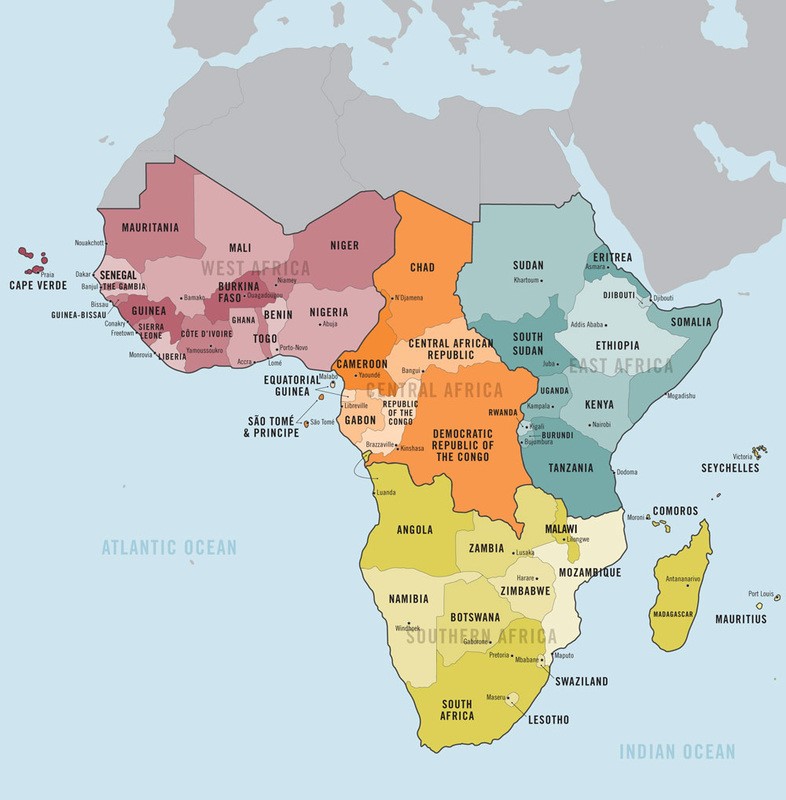
Sub-Saharan Africa and the Sustainable Development Goals
Recently, Dining for Women’s Board reaffirmed our commitment to the UN-mandated Sustainable Development Goals (SDGs). In the next nine months, a number of DFW featured grantees are from the Sub-Saharan Region of Africa. This offers DFW members the opportunity to learn about individual challenges faced by individual countries and communities in the vast region. This blog provides an overview of Sub-Saharan Africa in the context of the UN’s SDGs.
Sub-Saharan Africa is comprised of the 48 countries geographically located below the Sahara Desert and distinguished from the Northern African countries that are part of the Arab World. This beautiful region that makes up the bulk of the African continent consists of deserts, Sahel, savanna, swamps, rainforests, plateaus, mountains, rivers and lakes and enormous diversity in flora and fauna that has shaped human evolution in our geological past.
Today, the region has a combined population of close to 1 billion (the lowest population density of all the major continents) with hundreds of ethnic groups and close to 1,000 languages. The socio-political, economic, and human development landscape of this region is very diverse with considerable variability within countries. Agriculture is still a major occupation for most people in the region but since 1940, occupations have diversified with considerable migration to rapidly-changing urban areas. The average human lifespan for the region as a whole is only 58 years and several countries in Sub-Saharan Africa struggle to make progress on health and economic indicators.
The 17 SDGs adopted by the UN General Assembly in September 2015 are an unprecedented opportunity for countries and citizens of the world to forge pathways to improve the lives of all people everywhere and to combat climate change by 2030. According to the Overseas Development Institute, as we project progress of Sub-Saharan Africa towards the SDG Agenda of 2030, several key points are worth noting. For several of the SDG goals and targets, low starting points and inequality that exists between countries and within countries makes reaching these goals difficult by 2030. This region has 40 percent of its population who live in extreme poverty with a rate of undernourishment of 23 percent. There have been declines in poverty and undernourishment in the past decade but much more remains to be done. Large gains have been achieved in youth literacy and primary education, but poverty, armed conflict, child marriage and gender discrimination continue to be barriers for secondary and tertiary education, especially for girls.
Women’s access to paid employment is the most impressive progress in Sub-Saharan Africa and women continue to gain power in politics especially in Rwanda. There has been remarkable progress in bringing down the absolute rates of Maternal Mortality from a high of 990 per 100,000 in 1990 to 510 in 2013. Similarly, Child Mortality has seen huge declines from 179 per 1,000 in 1990 to 86 in 2013. It is notable that some of these declines have occurred in low-income countries like Eritrea, Ethiopia, Guinea, Liberia, Madagascar, Malawi, Mozambique, Niger, Rwanda, Uganda and Tanzania. Challenges remain to bring down these rates further, but experts in the field are heartened by the fact that low income in these countries is not a barrier to saving the lives of mothers and children.
For a region that has been hit the hardest during the HIV epidemic, the rate of new infections have been dropping steadily and the availability of anti-retroviral therapy since 1995 has averted at least 4.8 million HIV-related deaths. Challenges remain in the region where only a third of those between the ages of 15-24 have a comprehensive understanding about HIV.
A major focus of the SDGs is the impact of rising temperatures, rising sea levels, changing rainfall patterns, and the impact of weather-related disasters on health, water supply and sanitation, agriculture and food security, forestry and fisheries, energy, industry and trade. The impact of these macro indicators can be very severe on vulnerable communities such as those living in poverty in rural and urban areas, subsistence farming communities, and pastoral and nomadic communities that rely on the animals they herd for sustenance. The Sub-Saharan region has 50 million pastoralists who live in arid and semi-arid regions. In most vulnerable communities, women play key roles in managing the natural resources in their environment and, as such, are more impacted by climate change and its rippling effects.
According to the Overseas Development Institute, based on current trends with reference to the SDGs, Sub-Saharan Africa’s progress towards economic growth and domestic resource mobilization looks promising. Ending extreme poverty, reducing maternal mortality and access to energy require a redoubling of efforts. On the goals of reducing slum populations, reducing waste, reducing violent deaths, marine conservation and combatting climate change, trends in the region are headed in the wrong direction. Progress on these goals will require innovative solutions and strong efforts.
A vast region like Sub-Saharan Africa comprising of 48 different countries each with their own political systems, natural resources and political will to effect change collectively face challenges to reach their individual SDG goals and targets by 2030. DFW’s collaboration with grassroots efforts to bring about change in their communities is a drop in the bucket, but together we are part of that pathway to change.
Sources:
Collins, Robert O. and Burns, M. (2007). A history of Sub-Saharan Africa. New York: Cambridge University Press.
Mulinge, M.M. (2013). Climate Change: The Challenge of the 21st Century. In Mulinge, M.M & Getu, M. (Eds.), Climate Change and Variability on Pastorilist Women in Sub-Saharan Africa. Kampla: Fountain Publishers.
Nicolai, S., Hoy, C., Bhatkal, T., and Aedy, T. (2016). Projecting progress: The SDGs in sub-Saharan Africa. London: Overseas Development Institute.
United Nations. (2015). The Millennium Development Goals Report 2015: Regional Backgrounder Sub Saharan Africa.
